Multi - Criteria group decision making with picture linguistic numbers
In 2013, Cuong and Kreinovich defined picture fuzzy set (PFS) which is a direct extension of fuzzy set (FS) and
intuitionistic fuzzy set (IFS). Wang et al. (2014) proposed intuitionistic linguistic number (ILN) as a combination of
IFS and linguistic approach. Motivated by PFS and linguistic approach, this paper introduces the concept of picture
linguistic number (PLN), which constitutes a generalization of ILN for picture circumstances. For multi-criteria
group decision making (MCGDM) problems with picture linguistic information, we define a score index and two
accuracy indexes of PLNs, and propose an approach to the comparison between two PLNs. Simultaneously, some
operation laws for PLNs are defined and the related properties are studied. Further, some aggregation operations
are developed: picture linguistic arithmetic averaging (PLAA), picture linguistic weighted arithmetic averaging
(PLWAA), picture linguistic ordered weighted averaging (PLOWA) and picture linguistic hybrid averaging (PLHA)
operators. Finally, based on the PLWAA and PLHA operators, we propose an approach to handle MCGDM under
PLN environment.
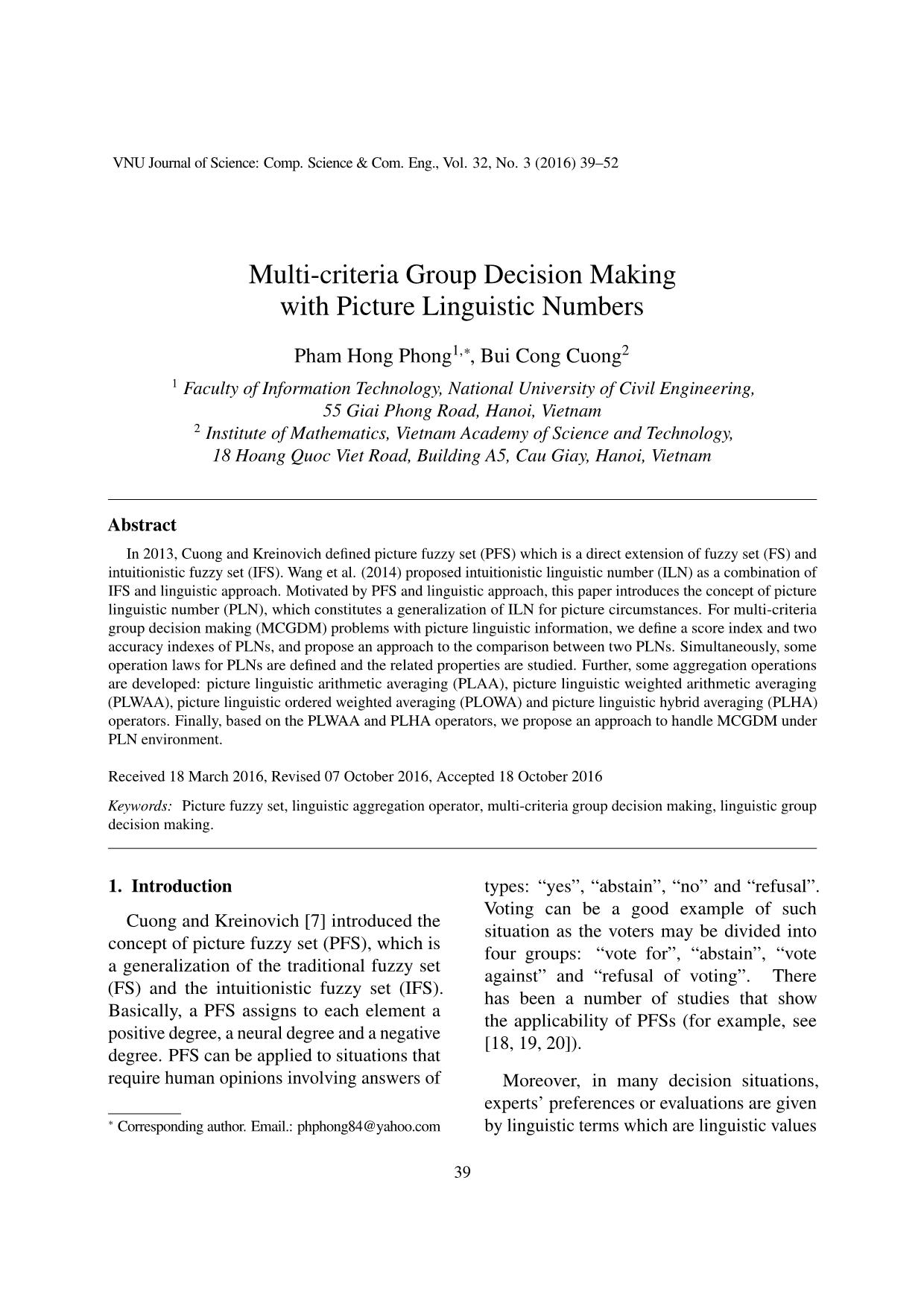
Trang 1
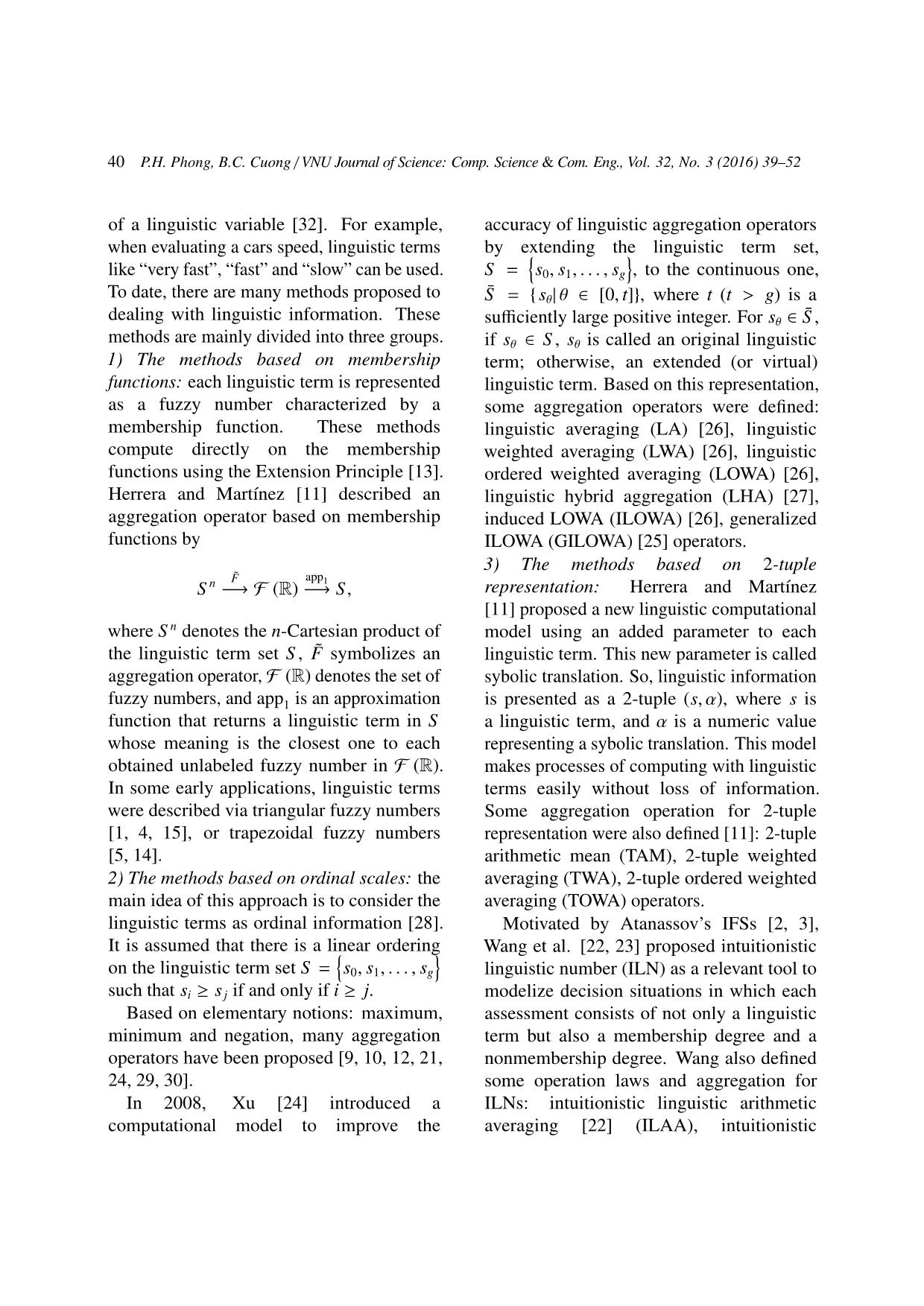
Trang 2
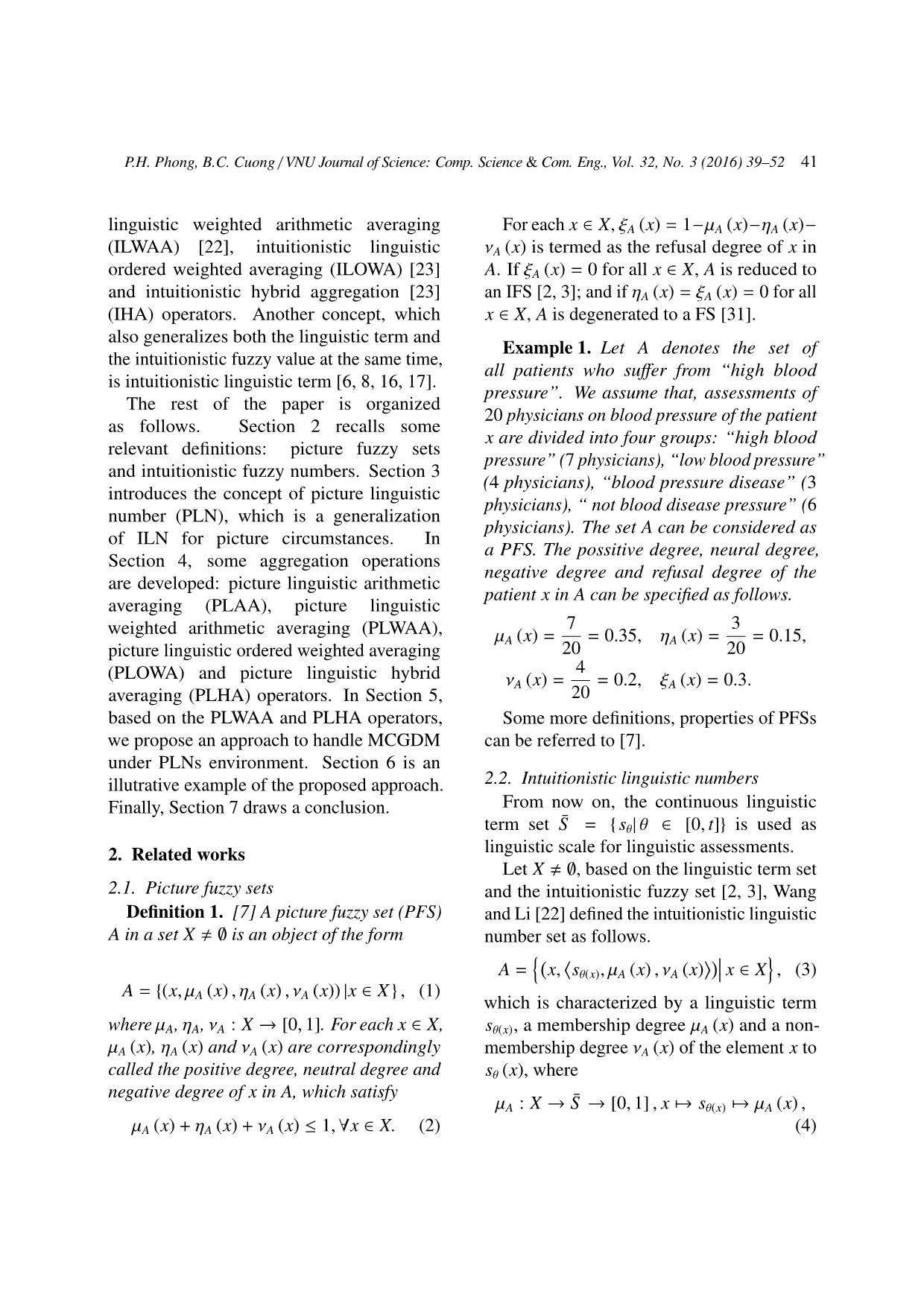
Trang 3
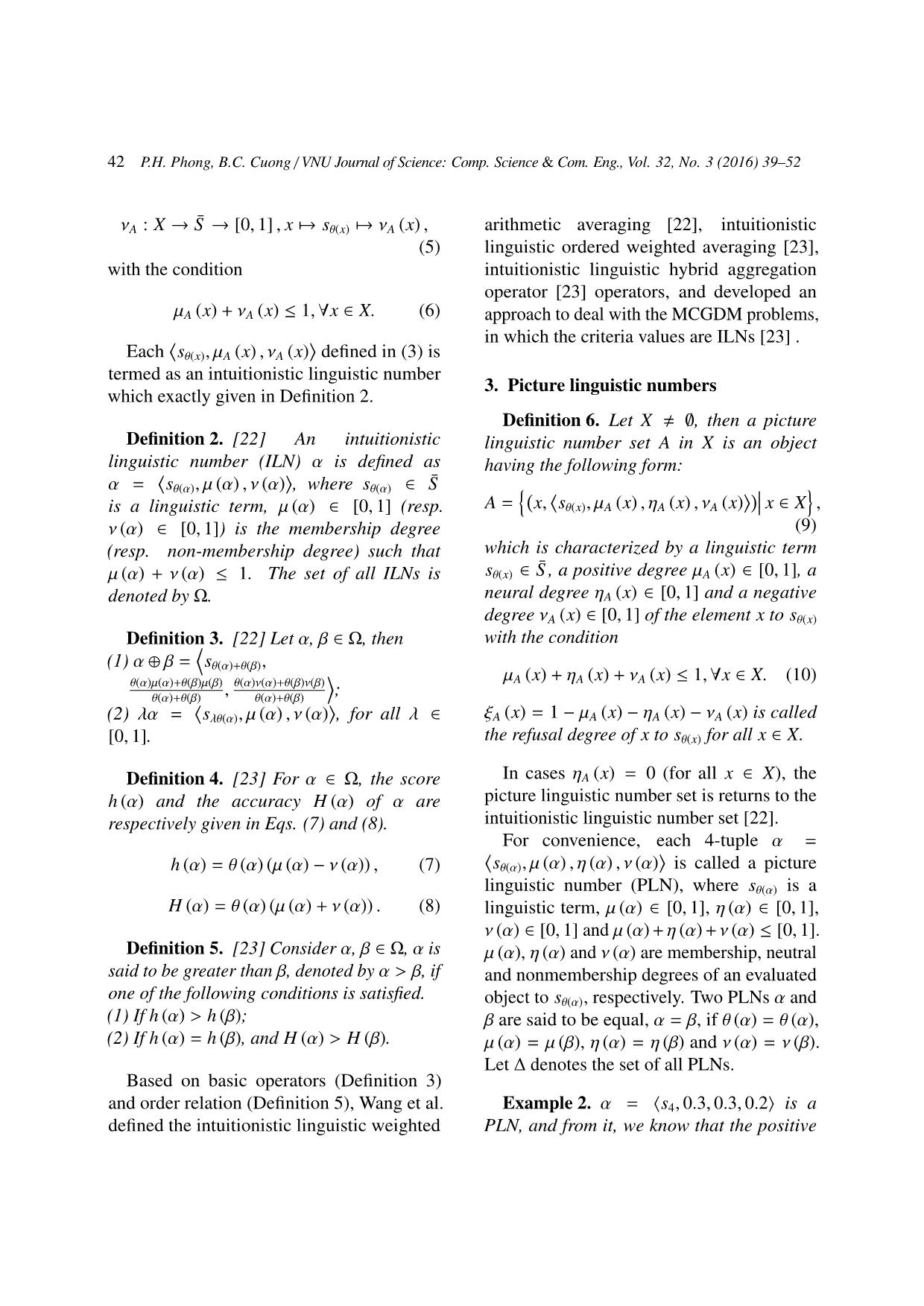
Trang 4
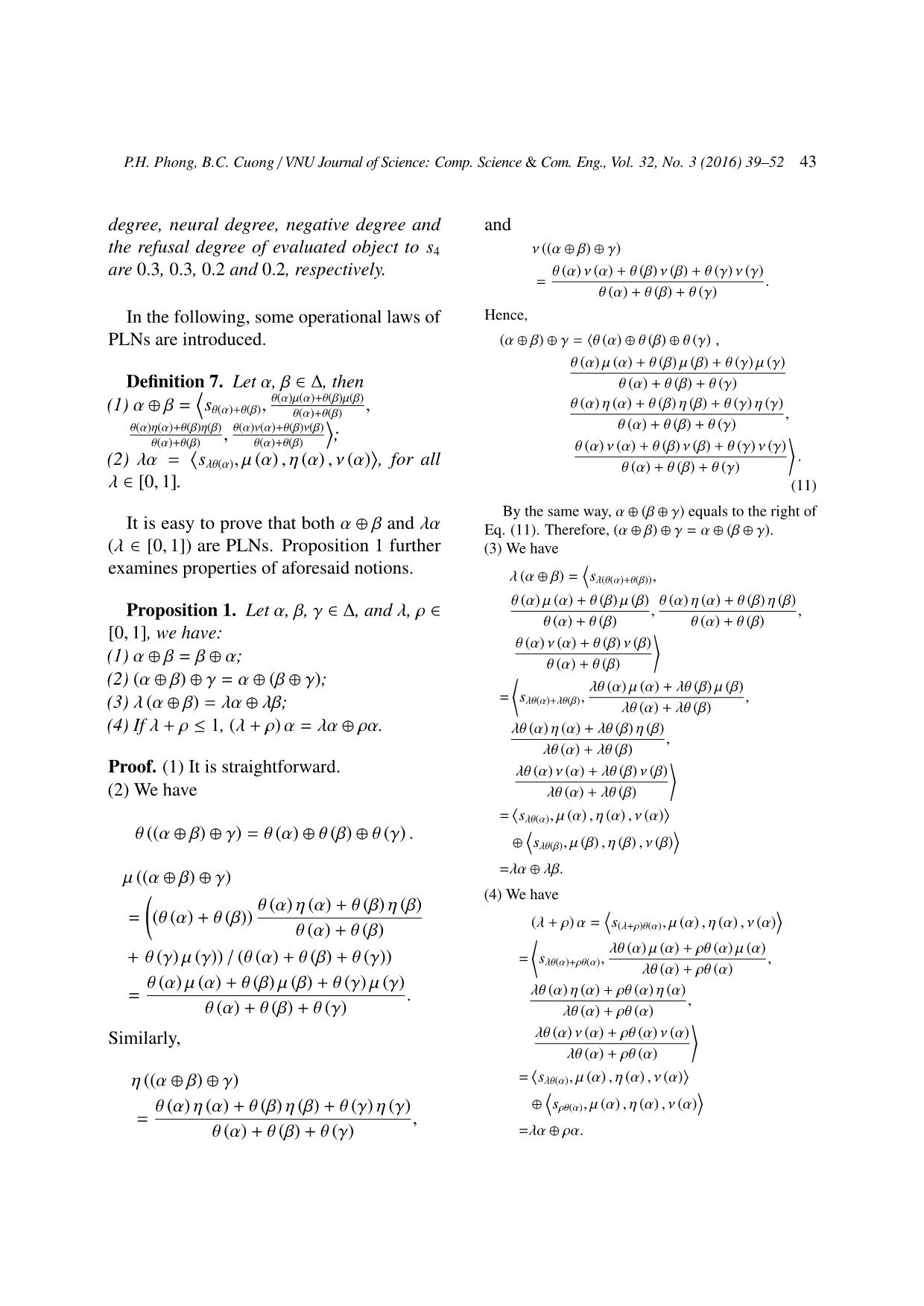
Trang 5
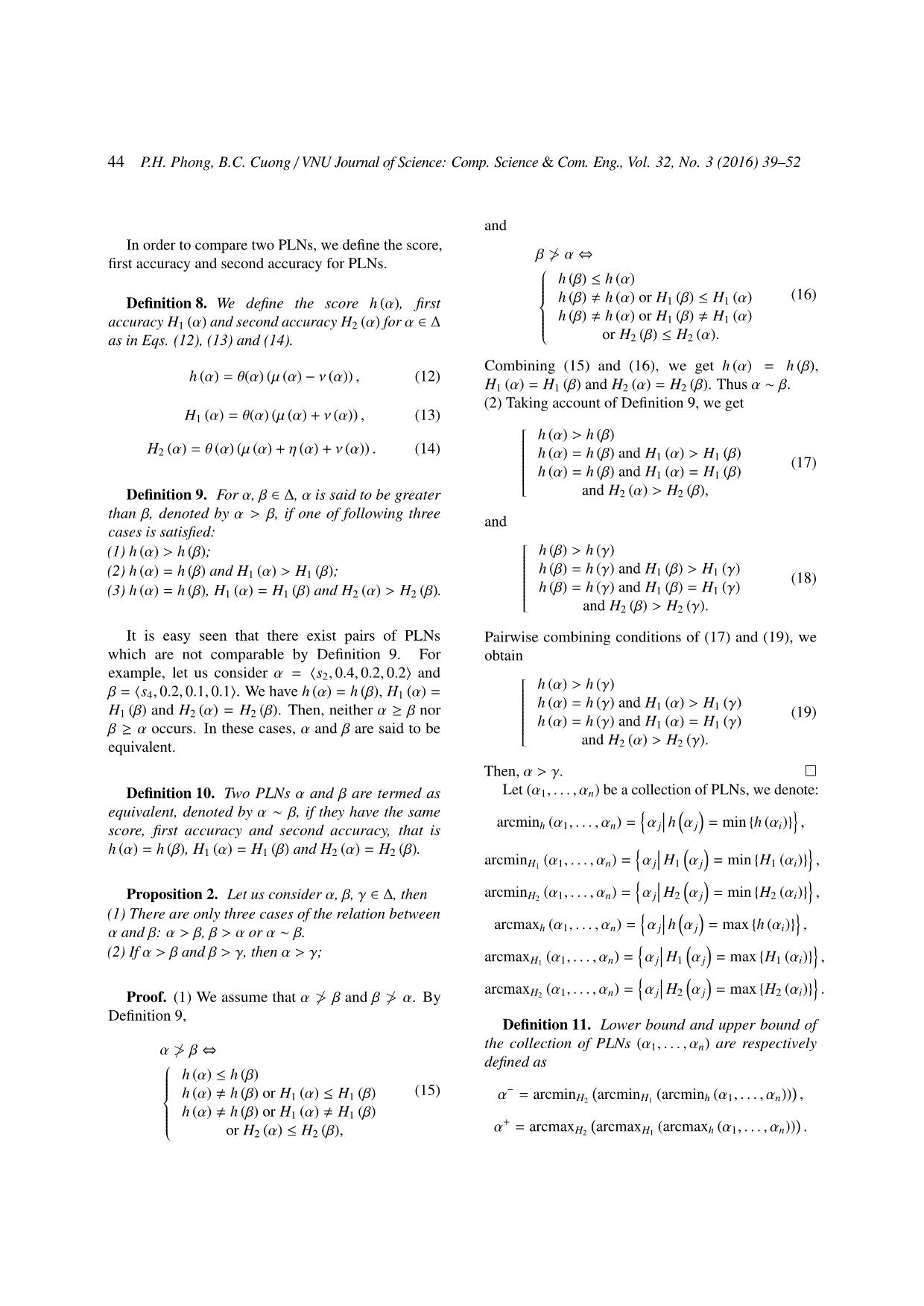
Trang 6
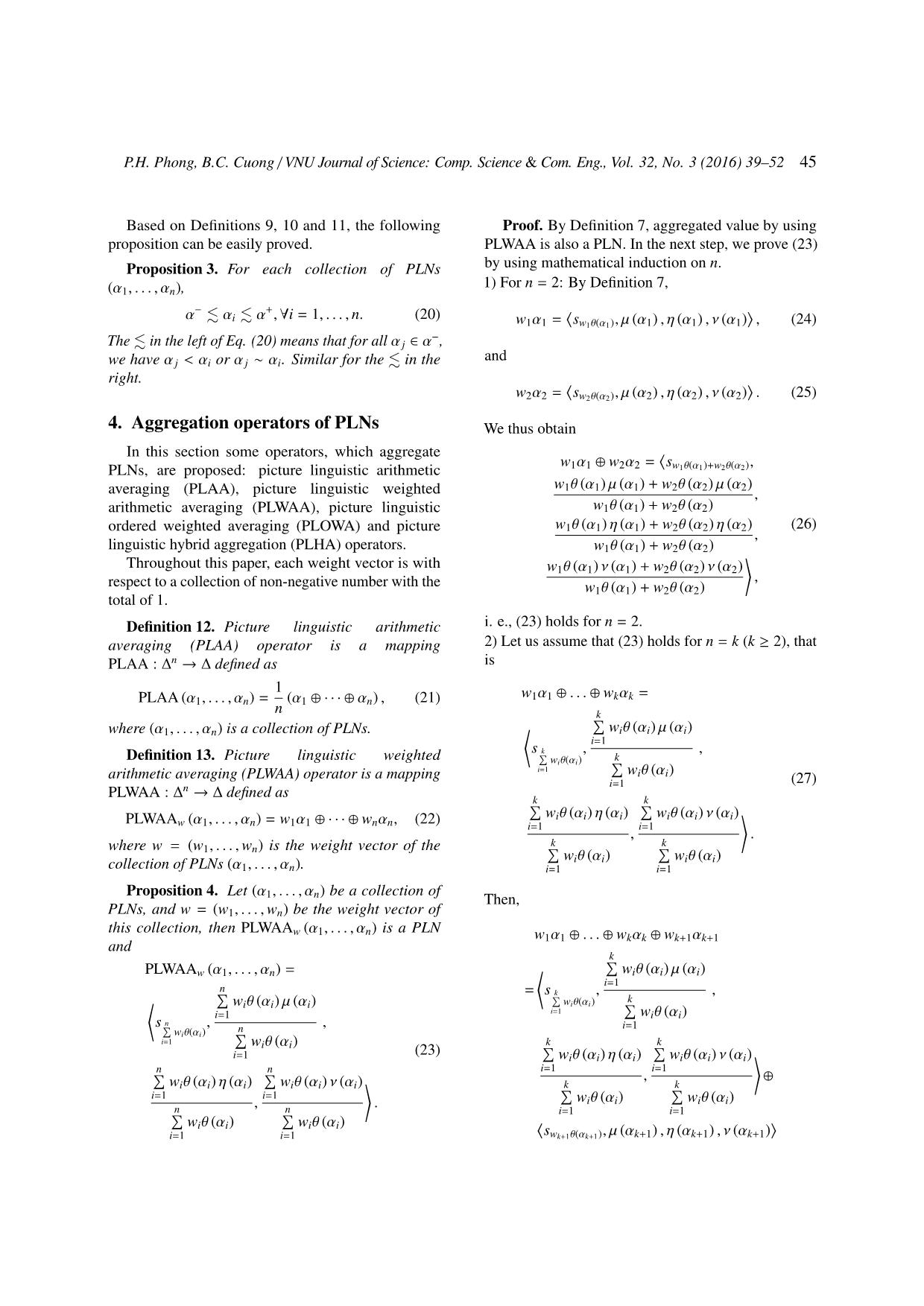
Trang 7
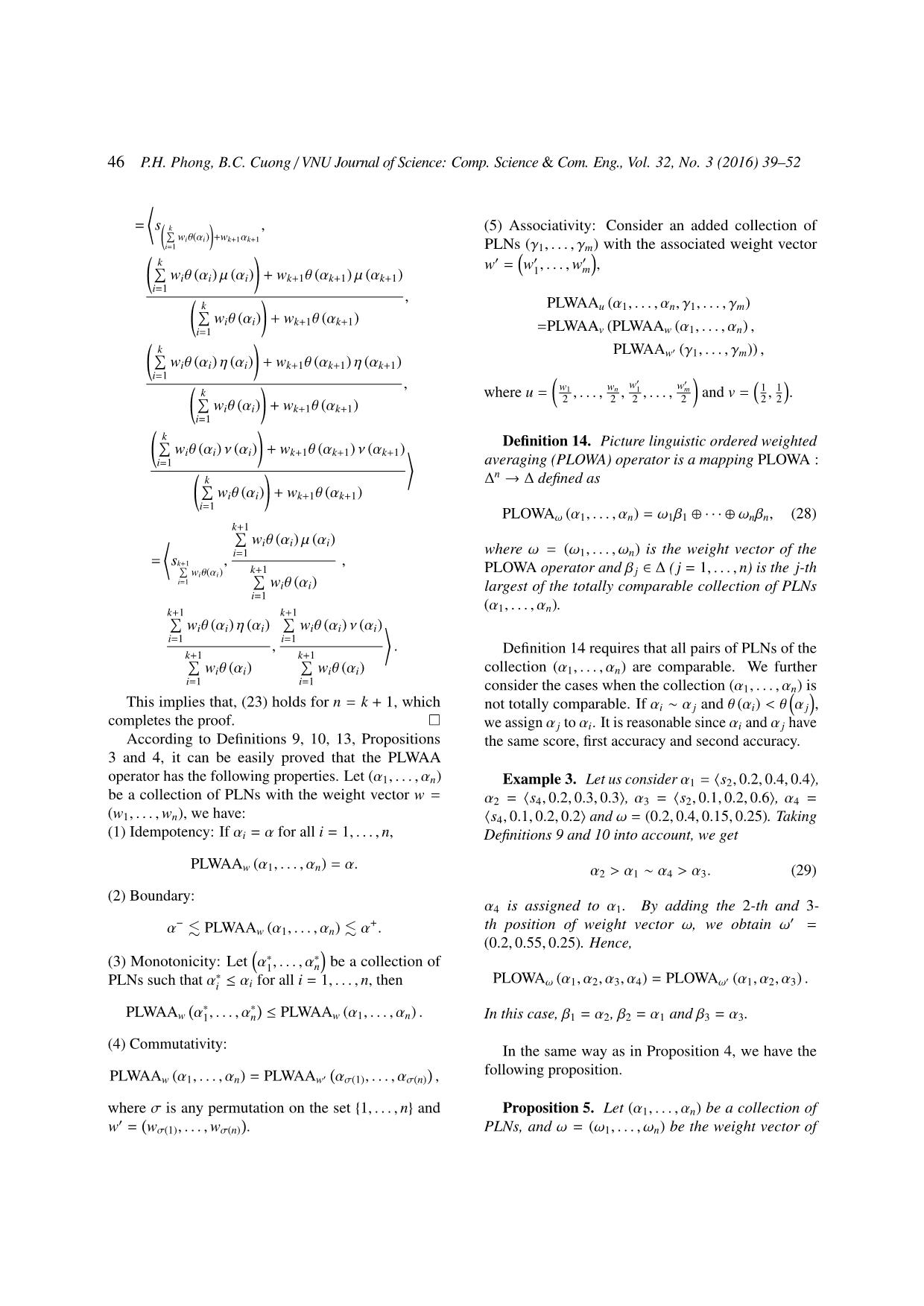
Trang 8
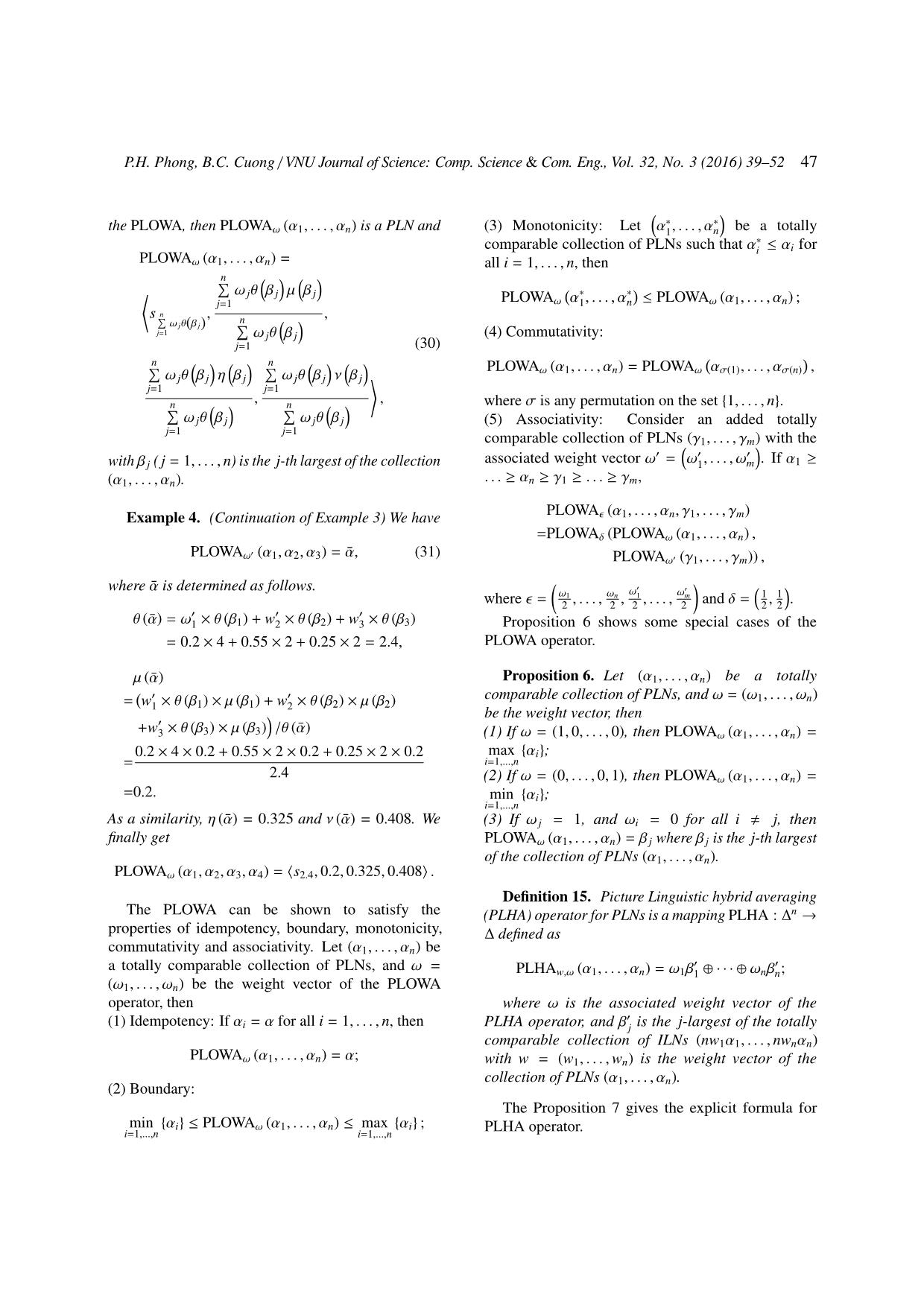
Trang 9
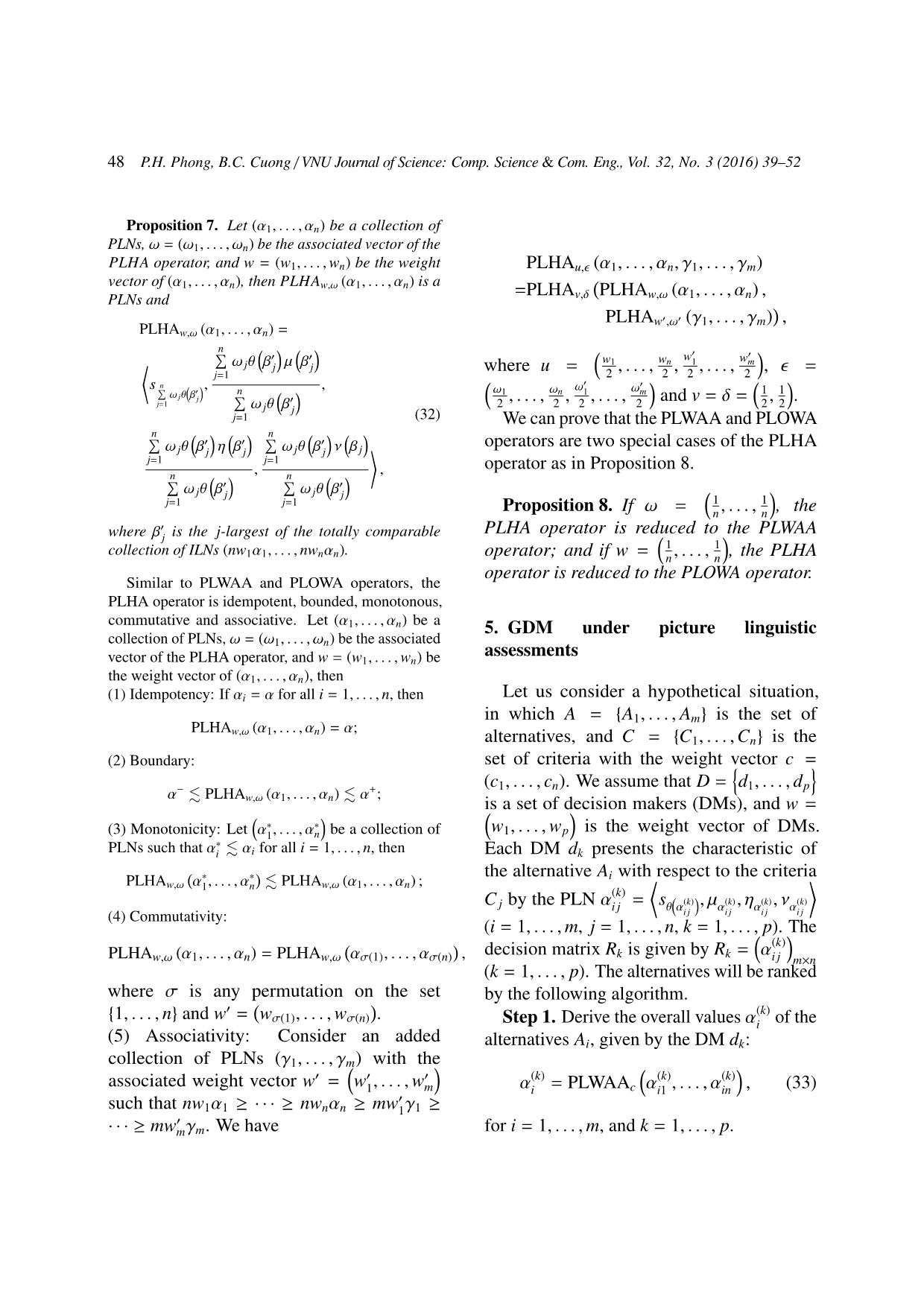
Trang 10
Tải về để xem bản đầy đủ
Tóm tắt nội dung tài liệu: Multi - Criteria group decision making with picture linguistic numbers
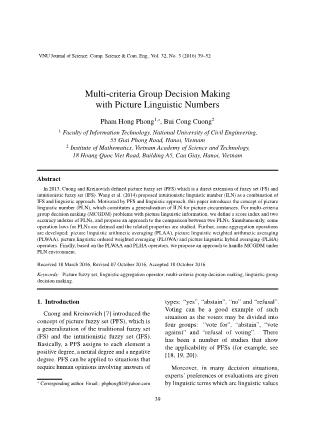
PLOWA (α1, . . . , αn, γ1, . . . , γm)
=PLOWAδ (PLOWAω (α1, . . . , αn) ,
PLOWA 0 (α , α , α ) = α,¯ (31)
ω 1 2 3 PLOWAω0 (γ1, . . . , γm)) ,
where α¯ is determined as follows. 0 0
ω1 ωn ω1 ωm 1 1
where = 2 ,..., 2 , 2 ,..., 2 and δ = 2 , 2 .
0 0 0
θ (α¯) = ω1 × θ (β1) + w2 × θ (β2) + w3 × θ (β3) Proposition 6 shows some special cases of the
= 0.2 × 4 + 0.55 × 2 + 0.25 × 2 = 2.4, PLOWA operator.
µ (α¯) Proposition 6. Let (α1, . . . , αn) be a totally
� 0 0 comparable collection of PLNs, and ω = (ω1, . . . , ωn)
= w1 × θ (β1) × µ (β1) + w2 × θ (β2) × µ (β2)
be the weight vector, then
w0 × θ (β ) × µ (β ) /θ (α)
+ 3 3 3 ¯ (1) If ω = (1, 0,..., 0), then PLOWAω (α1, . . . , αn) =
0.2 × 4 × 0.2 + 0.55 × 2 × 0.2 + 0.25 × 2 × 0.2 max {αi};
= i=1,...,n
2.4 (2) If ω = (0,..., 0, 1), then PLOWAω (α1, . . . , αn) =
=0.2. min {αi};
i=1,...,n
As a similarity, η (α¯) = 0.325 and ν (α¯) = 0.408. We (3) If ω j = 1, and ωi = 0 for all i , j, then
finally get PLOWAω (α1, . . . , αn) = β j where β j is the j-th largest
of the collection of PLNs (α1, . . . , αn).
PLOWAω (α1, α2, α3, α4) = hs2.4, 0.2, 0.325, 0.408i .
Definition 15. Picture Linguistic hybrid averaging
The PLOWA can be shown to satisfy the (PLHA) operator for PLNs is a mapping PLHA : ∆n →
properties of idempotency, boundary, monotonicity, ∆ defined as
commutativity and associativity. Let (α1, . . . , αn) be
a totally comparable collection of PLNs, and ω = 0 0
PLHAw,ω (α1, . . . , αn) = ω1β1 ⊕ · · · ⊕ ωnβn;
(ω1, . . . , ωn) be the weight vector of the PLOWA
operator, then where ω is the associated weight vector of the
0
(1) Idempotency: If αi = α for all i = 1,..., n, then PLHA operator, and β j is the j-largest of the totally
comparable collection of ILNs (nw1α1,..., nwnαn)
PLOWAω (α1, . . . , αn) = α; with w = (w1,..., wn) is the weight vector of the
collection of PLNs (α1, . . . , αn).
(2) Boundary:
The Proposition 7 gives the explicit formula for
min {αi} ≤ PLOWAω (α1, . . . , αn) ≤ max {αi} ;
i=1,...,n i=1,...,n PLHA operator.
48 P.H. Phong, B.C. Cuong / VNU Journal of Science: Comp. Science & Com. Eng., Vol. 32, No. 3 (2016) 39–52
Proposition 7. Let (α1, . . . , αn) be a collection of
PLNs, ω = (ω1, . . . , ωn) be the associated vector of the
PLHA operator, and w = (w1,..., wn) be the weight PLHAu, (α1, . . . , αn, γ1, . . . , γm)
vector of (α1, . . . , αn), then PLHAw,ω (α1, . . . , αn) is a �
=PLHAv,δ PLHAw,ω (α1, . . . , αn) ,
PLNs and
PLHAw0,ω0 (γ1, . . . , γm) ,
PLHAw,ω (α1, . . . , αn) =
n
P 0 0 0 0
w1 wn w1 wm
* ω jθ β j µ β j where u = ,..., , ,..., , =
j=1 2 2 2 2
s n , , ω0 ω0
P ω θ β0 n ω1 ωn 1 m 1 1
j j P 0 ,..., , ,..., and v = δ = , .
j=1 2 2 2 2 2 2
ω jθ β j
j=1 (32) We can prove that the PLWAA and PLOWA
n n
P 0 0 P 0 operators are two special cases of the PLHA
ω jθ β j η β j ω jθ β j ν β j +
j=1 j=1 operator as in Proposition 8.
n , n ,
P 0 P 0
ω jθ β j ω jθ β j
j=1 j=1 1 1
Proposition 8. If ω = n ,..., n , the
where β0 is the j-largest of the totally comparable PLHA operator is reduced to the PLWAA
j
collection of ILNs (nw α ,..., nw α ). 1 1
1 1 n n operator; and if w = n ,..., n , the PLHA
operator is reduced to the PLOWA operator.
Similar to PLWAA and PLOWA operators, the
PLHA operator is idempotent, bounded, monotonous,
commutative and associative. Let (α1, . . . , αn) be a 5. GDM under picture linguistic
collection of PLNs, ω = (ω , . . . , ω ) be the associated
1 n assessments
vector of the PLHA operator, and w = (w1,..., wn) be
the weight vector of (α1, . . . , αn), then
(1) Idempotency: If αi = α for all i = 1,..., n, then Let us consider a hypothetical situation,
in which A = {A1,..., Am} is the set of
PLHAw,ω (α1, . . . , αn) = α;
alternatives, and C = {C1,..., Cn} is the
c
(2) Boundary: set of criteria with the weight vectorn =o
(c1,..., cn). We assume that D = d1,..., dp
α− PLHA (α , . . . , α ) α+;
. w,ω 1 n . is a set of decision makers (DMs), and w =
∗ ∗ w ,..., w is the weight vector of DMs.
(3) Monotonicity: Let α1, . . . , αn be a collection of 1 p
∗
PLNs such that αi . αi for all i = 1,..., n, then Each DM dk presents the characteristic of
� ∗ ∗ the alternative Ai with respect to the criteria
PLHAw,ω α1, . . . , αn . PLHAw,ω (α1, . . . , αn) ;
(k)
C j by the PLN αi j = sθ α(k) , µα(k) , ηα(k) , να(k)
(4) Commutativity: i j i j i j i j
(i = 1,..., m, j = 1,..., n, k = 1,..., p). The
(k)
� decision matrix Rk is given by Rk = α
PLHAw,ω (α1, . . . , αn) = PLHAw,ω ασ(1), . . . , ασ(n) , i j m×n
(k = 1,..., p). The alternatives will be ranked
where σ is any permutation on the set by the following algorithm.
0 � (k)
{1,..., n} and w = wσ(1),..., wσ(n) .
Step 1. Derive the overall values αi of the
(5) Associativity: Consider an added alternatives Ai, given by the DM dk:
collection of PLNs (γ , . . . , γ ) with the
1 m
associated weight vector w0 = w0 ,..., w0 (k) (k) (k)
1 m αi = PLWAAc αi1 , . . . , αin , (33)
0
such that nw1α1 ≥ · · · ≥ nwnαn ≥ mw1γ1 ≥
0
· · · ≥ mwmγm. We have for i = 1,..., m, and k = 1,..., p.
P.H. Phong, B.C. Cuong / VNU Journal of Science: Comp. Science & Com. Eng., Vol. 32, No. 3 (2016) 39–52 49
Table 1. Decision matrix R1
C1 C2 C3
A1 hs4, 0.6, 0.1, 0.2i hs4, 0.4, 0.2, 0.2i hs5, 0.2, 0.3, 0.5i
A2 hs5, 0.7, 0.2, 0.1i hs4, 0.4, 0.1, 0.4i hs4, 0.5, 0.2, 0.3i
A3 hs5, 0.3, 0.1, 0.4i hs5, 0.4, 0.3, 0.3i hs6, 0.7, 0.1, 0.2i
A4 hs4, 0.6, 0.1, 0.2i hs4, 0.6, 0.1, 0.2i hs5, 0.3, 0.1, 0.5i
Step 2. Derive the collective overall values Ai (i = 1, 2, 3, 4) by the PLHA operator with
αi by aggregating the individual overall values associated weight vector ω = (0.2, 0.5, 0.3).
(1) (p)
αi , . . . , αi :
α1 = hs4.40, 0.3965, 0.2045, 0.3438i ,
(1) (p) h i
αi = PLHAw,ω αi , . . . , αi , (34) α2 = s4.57, 0.3481, 0.1428, 0.4040 ,
α = hs , 0.3628, 0.1666, 0.4050i ,
3 5.32
where ω = ω1, . . . , ωp is the weight vector α4 = hs5.16, 0.4098, 0.1510, 0.3948i .
of the PLHA operator (i = 1,..., m).
Step 3. Calculate the scores h (αi), first Step 3. By eq. (12),
accuracies H1 (αi) and second accuracies
h (α1) = 0.2318, h (α2) = −0.2556
H2 (αi) (i = 1,..., m), rank the alternatives
−
by using Definition 9 (the alternative Ai1 is h (α3) = 0.2246, h (α4) = 0.078.
called to be better than the alternative Ai ,
2 By Definition 9,
denoted by Ai1 > Ai2 , iff αi1 > αi2 , for all
i1, i2 = 1,..., m).
h (α1) > h (α4) > h (α3) > h (α2)
6. An illutrative example then A1 > A4 > A3 > A2.
This situation concerns four alternative 7. Conclusion
enterprises, which will be chosen by
three DMs whose weight vector is w = In this paper, motivated by picture fuzzy
(0.3, 0.4, 0.3). The enterprises will be sets and linguistic approaches, the notion
considered under three criteria C1, C2 and C3. of picture linguistic numbers are first
Assume that the weight vector of the criteria defined. We propose the score, first accuracy
is c = (0.37, 0.35, 0.28). Three decision and second accuracy of picture linguistic
matrices are listed in Tabs. 1, 2 and 3. numbers, and propose a simple approach
Step 1. Using explicit form of the PLWAA for the comparison between two picture
operation given in Eq. 23, we obtain overall linguistic numbers. Simultaneously, the
(k)
values αi of the alternatives Ai given by the operation laws for picture linguistic numbers
DMs dk (i = 1, 2, 3, 4 and k = 1, 2, 3) as are given and the accompanied properties are
in Tab. 4. studied. Further, some aggregation operators
Step 2. Aggregate all the individual overall are developed: picture linguistic arithmetic
(1) (2) (3)
values αi , αi and αi of the alternatives averaging, picture linguistic weighted
50 P.H. Phong, B.C. Cuong / VNU Journal of Science: Comp. Science & Com. Eng., Vol. 32, No. 3 (2016) 39–52
Table 2. Decision matrix R2
C1 C2 C3
A1 hs4, 0.7, 0.1, 0.2i hs6, 0.2, 0.2, 0.5i hs4, 0.7, 0.2, 0.1i
A2 hs3, 0.2, 0.2, 0.6i hs5, 0.5, 0.1, 0.2i hs5, 0.3, 0.1, 0.4i
A3 hs4, 0.2, 0.1, 0.5i hs7, 0.2, 0.2, 0.6i hs5, 0.1, 0.2, 0.6i
A4 hs5, 0.7, 0.2, 0.1i hs5, 0.2, 0.1, 0.7i hs4, 0.6, 0.1, 0.2i
Table 3. Decision matrix R3
C1 C2 C3
A1 hs4, 0.6, 0.3, 0.1i hs6, 0.2, 0.3, 0.5i hs5, 0.2, 0.1, 0.7i
A2 hs3, 0.2, 0.2, 0.5i hs5, 0.2, 0.1, 0.6i hs6, 0.2, 0.2, 0.6i
A3 hs5, 0.3, 0.2, 0.5i hs7, 0.8, 0.1, 0.1i hs5, 0.2, 0.2, 0.5i
A4 hs3, 0.7, 0.1, 0.2i hs5, 0.2, 0.2, 0.5i hs6, 0.3, 0.1, 0.6i
(k)
Table 4. Overall values αi of the alternatives Ai given by the DMs dk (i = 1, 2, 3, 4; k = 1, 2, 3)
d1 d2 d3
A1 hs4.28, 0.4037, 0.1981, 0.2981i hs4.70, 0.4766, 0.1685, 0.3102i hs4.98, 0.3189, 0.2438, 0.4373i
A2 hs4.37, 0.5526, 0.1680, 0.2474i hs4.26, 0.3561, 0.1261, 0.3700i hs4.54, 0.2000, 0.1615, 0.5756i
A3 hs5.28, 0.4604, 0.1663, 0.3032i hs5.33, 0.1737, 0.1722, 0.5722i hs5.70, 0.4904, 0.1570, 0.3281i
A4 hs4.28, 0.5019, 0.1000, 0.2981i hs5.28, 0.4070, 0.1682, 0.3917i hs4.54, 0.3593, 0.1385, 0.4637i
arithmetic averaging, picture linguistic References
ordered weighted averaging and picture
[1] G. I. Adamopoulos and G. P. Pappis, A
linguistic hybrid aggregation operators. fuzzy linguistic approach to a multicriteria
Finally, based on the picture linguistic sequencing problem, European Journal of
weighted arithmetic averaging and the picture Operational Research 92 (1996) 628–636.
linguistic hybrid aggregation operators, we [2] K. T. Atanassov, Intuitionistic fuzzy sets,
propose an approach to handle multi-criteria Fuzzy Sets and Systems 20 (1986) 87–96.
[3] K. T. Atanassov and S. Stoeva, Intuitionistic
group decision making problems under L-fuzzy sets, in Cybernetics and Systems
picture linguistic environment. Research, eds. R. Trappl (Elsevier Science
Pub., Amsterdam, 1986), pp. 539–540.
[4] P. Chang and Y. Chen, A fuzzy multicriteria
Acknowledgments decision making method for technology
transfer strategy selection in biotechnology,
This research is funded by the Vietnam Fuzzy Sets and Systems 63 (1994) 131-139.
National Foundation for Science and [5] S. M. Chen, A new method for tool steel
Technology Development (NAFOSTED) materials selection under fuzzy environment,
under grant number 102.01- 2017.02. Fuzzy Sets and Systems 92 (1997) 265–274.
[6] Z. C. Chen, P. H. Liu and Z. Pei, An
approach to multiple attribute group decision
making based on linguistic intuitionistic
fuzzy numbers, International Journal of
P.H. Phong, B.C. Cuong / VNU Journal of Science: Comp. Science & Com. Eng., Vol. 32, No. 3 (2016) 39–52 51
Computational Intelligence Systems 8 (4) fuzzy sets, Journal of Intelligent & Fuzzy
(2015) 747–760. Systems28 (2) (2015) 591-604.
[7] B. C. Cuong and V. Kreinovich, Picture [19] L. H. Son, DPFCM: A novel distributed
fuzzy sets - a new concept for computational picture fuzzy clustering method on picture
intelligence problems, in Proc. 3rd world fuzzy sets, Expert Systems with Applications
congress on information and communication 42 (2015) 51–66.
technologies (WICT 2013) pp. 1–6. [20] P. H. Thong and L. H. Son, Picture
[8] B. C. Cuong and P. H. Phong, Max - fuzzy clustering: a new computational
Min Composition of Linguistic Intuitionistic intelligence method, Soft Computing DOI
Fuzzy Relations and Application in Medical 10.1007/s00500-015-1712-7
Diagnosis, VNU Journal of Science: Comp. [21] V. Torra, The weighted OWA operator,
Science & Com. Eng. 30 (4) (2014) 601–968. International Journal of Intelligent Systems
[9] F. Herrera and J. L. Verdegay, Linguistic 12 (1997) 153–166.
assessments in group decision”, in Proc. [22] J. Q. Wang and H. B. Li, Multi-criteria
First European Congress on Fuzzy and decision-making method based on
Intelligent Technologies (Aachen, 1993) pp. aggregation operators for intuitionistic
941–948. linguistic fuzzy numbers, Control and
[10] F. Herrera and E. Herrera-Viedma, Decision 25 (10) (2010) 1571–1574, 1584.
Aggregation operators for linguistic [23] X. F. Wang, J. Q. Wang and W. E. Yang,
weighted information, IEEE Transactions Multi-criteria group decision making method
on Systems, Man, and Cybernetics-Part A 27 based on intuitionistic linguistic aggregation
(1997), 646–656. operators, Journal of Intelligent & Fuzzy
[11] F. Herrera and L. Mart´ınez, A 2-tuple Systems 26 (2014), 115–125.
fuzzy linguistic representation model for [24] Z. S. Xu, Uncertain Multiple Attribute
computing with words, IEEE Transactions Decision Making: Methods and Applications
on Fuzzy Systems 8 (2000) 746–752. (Tsinghua University Press, Beijing, 2004).
[12] F. Herrera and E. Herrera-Viedma, Choice [25] Z. S. Xu , Method based on fuzzy linguistic
functions and mechanisms for linguistic assessments and GIOWA operator in multi-
preference relations, European Journal of attribute group decision making, Journal of
Operational Research 120 (2000) 144–161. Systems Science and Mathematical Sciences
[13] G. J. Klir and B. Yuan, Fuzzy sets an fuzzy 24 (2004) 218–224.
logic: Theory and Applications (Prentice- [26] Z. S. Xu, On generalized induced linguistic
Hall PTR, 1995). aggregation operators, International Journal
[14] C. K. Law, Using fuzzy numbers in of General Systems 35 (2006) 17–28.
educational grading systems, Fuzzy Sets and [27] Z. S. Xu, A note on linguistic hybrid
Systems 83 (1996) 311–323. arithmetic averaging operator in group
[15] H. M. Lee, Applying fuzzy set theory decision making with linguistic information,
to evaluate the rate of aggregative risk Group Decision and Negotiation 15 (2006)
in software development, Fuzzy Sets and 581–591.
Systems 80 (1996) 323–336. [28] R. R. Yager, A new methodology for ordinal
[16] P. H. Phong and B. C. Cuong, Some multiobjective decisions based on fuzzy sets,
intuitionistic linguistic aggregation Decision Sciences 12 (1981) 589–600.
operators, Journal of Computer Science and [29] R. R. Yager, Applications and extensions of
Cybernetics 30 (3) (2014) 216–226. OWA aggregations, International Journal of
[17] P. H. Phong and B. C. Cuong, Symbolic Man-Machine Studied 37 (1992) 103–132.
computational models for intuitionistic [30] R. R. Yager and A. Rybalov, Understanding
linguistic information, Journal of Computer the median as a fusion operator,
Science and Cybernetics 32 (1) (2016) 30– International Journal of General Systems 26
44. (1997) 239-263.
[18] P. Singh, Correlation coefficients for picture
52 P.H. Phong, B.C. Cuong / VNU Journal of Science: Comp. Science & Com. Eng., Vol. 32, No. 3 (2016) 39–52
[31] L. A. Zadeh, Fuzzy sets, Information and variable and its application to approximate
Control 8, 338–353. reasoning-I, Information Sciences 8 (3)
[32] L. A. Zadeh, The concept of a linguistic (1975)199–249.File đính kèm:
 multi_criteria_group_decision_making_with_picture_linguistic.pdf
multi_criteria_group_decision_making_with_picture_linguistic.pdf

